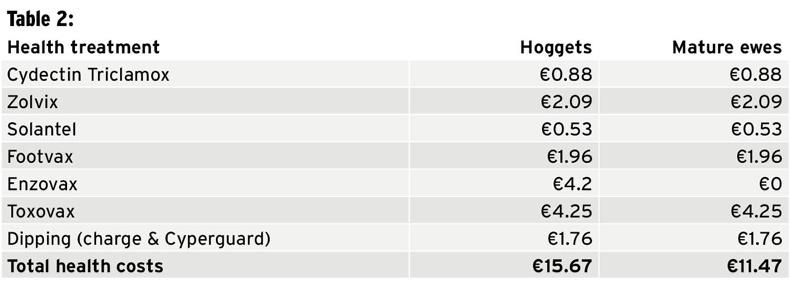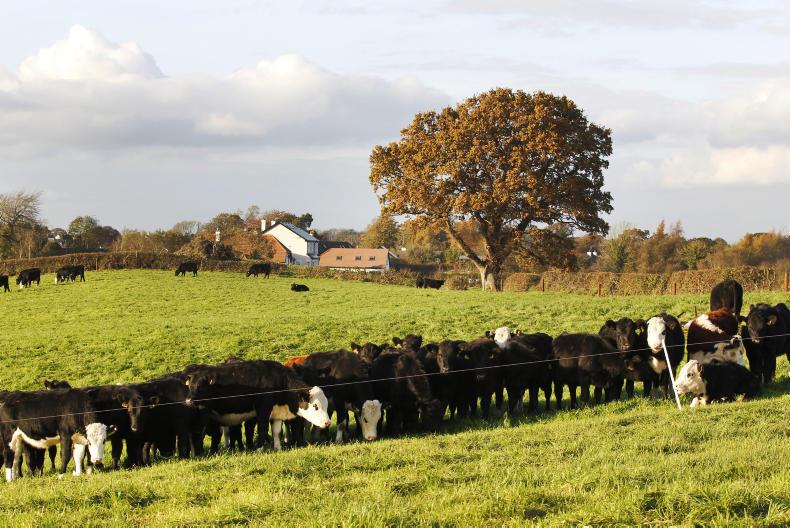Grass has continued to grow albeit at a lower rate over the past two weeks. The farm grew 21kg DM/ha over the past seven days. Demand has dropped to 12kg DM/ha. Farm cover is running at 610kg DM/ha.
The plan is to close the farm at a cover of 750kg DM/ha. This will ensure sufficient grass for early turnout of weanlings next February. There is currently 63% (50.6ha) of the farm closed and paddocks closed in early October have covers of 1,000-1,200kg/DM at the moment.
The plan is to have all cattle housed by 1 December. Sheep will continue to graze reseeded paddocks over the next four to five weeks and will be housed in mid- December. These low-lying reseeded paddocks would be unable to be grazed by cattle so we are lucky to have the ewes to graze these reseeds.
Eighty per cent of the farm was spread with a bag/acre of MOP. MOP isn’t coming in cheap, costing €350/t but is necessary to lift the soil K levels on the farm which are at a very low level. This will add significant costs to the farm’s fertiliser bill for 2017.
Total fertiliser spread in 2017 finished at 170kg/N/ha. This included fertiliser used for reseeding. Eighty per cent of the farm has been reseeded, using predominantly the plough, till, sow method, with some paddocks being reseeded using a min till machine.
Varieties used have included mixes of Abergain, Aberchoice, Astonenergy, Aspect and Kintyre. Clover varieties include Aberherald, Buddy and Crusader. Grass grown up until 31 October currently stands at 9.97t DM/ha. This is broken down into 7.81t DM of grazed grass and 2.16t of silage/DM/ha.
Paddocks are ranging between 4.38t DM/ha for the lowest-producing paddock to 17.6t in the top-performing paddock.
When the farm is fully stocked, it will need to grow 14t DM/ha to meet the farm’s feed demand. The 21ha reseeded in 2016 have grown 14.6t DM/ha.
Surprisingly, four of the wettest paddocks on the farm that were not reseeded yet have grown 8t, 15.8t, 10.4t and 14.4t respectively. Increasing soil fertility and increased grazing pressure has had a positive impact on the grass production.
Silage quality
Silage was analysed last month and a variety of results were returned. As expected, bales taken off reseeded paddocks have the highest DMD and protein levels. This silage will be fed to the bull weanlings and heifer weanlings.
Poorest-quality silage bales have been fed to cows around the drying-off period and will also be fed to cows which are over BCS 4 and can afford to lose some condition before calving.
While silage quality isn’t where we need it to be, this was expected in year one where there was a low level of perennial ryegrass in the swards.
Fencing
Fencing contractors started working on the TAMS-approved fencing in October and have been making good progress. This fencing coincides with the ewes moving on to the farm in mid-October and paddocks are being grazed off with the ewes as fencing is completed.
All boundary fencing is 32in sheep wire and one row of electric costing €4.90/m. Twelve-foot heavy duty gates are costing €160/gate and 14ft heavy duty gates are costing €190/m. Gate posts are costing €39/post.
Some of the electric fencing on cattle paddocks will be amended over the winter months with two more strands to help graze sheep and cattle together next spring.
Weanling performance
All animals were weighed on 6 October and calf performance was good, with calves hitting weaning weight targets. Male calves weighed 302kg and gained 1.22kg/day since birth. Heifer calves weighed 276kg (range: 181kg-402kg) and gained 1.11kg/day since birth. Cow weight averaged 590kg with a range from 420kg to 874kg.
Based on cow liveweight at mid-season and calf liveweight at 200 days, the current weaning efficiency of the cows is 47%. The target next year will be to hit 50%. All weanlings were dosed for worms and vaccinated for pneumonia prior to weaning. Dairy x AA and HE heifer calves weighed 203kg (range: 143kg-243kg) and gained .77kg/day since birth. These calves are a little behind where they need to be and will fall short of hitting the 230kg target on 1 November.
These dairy x calves go on to kale on 1 December until early March. They will also be earmarked for early turnout where hopefully they will make up the deficit. The weanling bulls were housed on Friday 27 October and are being fed 3kg of a 16% protein ration. They are being fed a barley, soya hulls, maize meal and soya bean meal mix costing €250/t.
They are also being fed the highest-quality silage at 78DMD. They will stay on 3kg of ration for November and gradually move up to ad-lib feeding in February. Weanling heifers will continue to graze off paddocks for the next two weeks and are getting 2kg/head/day at grass.
Kale feeding
Eleven acres of Maris Kestrel kale was planted on 12 June and has done very well. It is currently yielding 10.5t DM/ha.
Fifty-one cows started to graze kale on Friday 3 November. Their tails were clipped and each cow received two mineral boluses. They have access to silage bales as they graze the kale. The recent dry conditions have helped settle them into grazing and they seem very happy on it.
The fence is being moved daily and silage is being fed in the form of round bales positioned in the kale during the summer months. Cows have access to a lie-back area in an adjacent paddock. These cows will stay on kale until 31 January, just before calving starts.
Cull cows
The fertility issues with the stock bulls has meant that there are an extra 26 cows for culling this year.
Options including autumn calving, breeding again in 2018 and selling as breeding cows have all been looked at but the decision has been made to finish them in the next two months.
Some of the cows have come indoors in really good condition and shouldn’t require a lot of feeding to finish. They are currently being fed 4kg of finishing ration and will move up to 5-6kg in the next week.
There are currently 97 cows to calve in spring 2018 and a decision has been made to hold current cow numbers at 100 and maintain our dairy beef enterprise in 2018.

Breeding in the ewe flock commenced on 2 November, three weeks after Toxovax was administered to the last ewes receiving vaccination. Four mature Charollais rams were joined to the batch of 150 mature Mule ewes while a mature Charollais ram was joined to the batch of 20 Mule hoggets.
The four rams were fitted with harnesses and yellow crayon, while handling facilities where the fourth ram is being run are more suitable to catching this ram easier. As such, yellow raddle powder was applied.
The raddle colour will be changed weekly to keep a better handle on breeding dates while the single Charollais ram will be switched back to the mature ewe group to guard against infertility.
Quarantine procedure
An extensive quarantine health programme was put in place to reduce the risk of importing disease on to the farm. Sheep were housed on arrival and remained indoors while a number of health treatments were administered.
Special care was taken to limit the chance of resistant worms being imported, with all sheep receiving the recommended two-dose quarantine treatment of Zolvix (or Startect can also be used) and a moxidectin-based product with Cydectin Triclamox used in Tullamore.
This also provided one of the recommended liver fluke treatments to administer a product with the active ingredient triclabendazole with Solantel providing a secondary treatment with the active ingredient closantel.
The health of all feet were checked and as ewes were previously on a Footvax vaccination programme a decision was taken to continue this. Regular foot-bathing will also be used to keep on top of potential issues. There are no dipping facilities on the farm and a contractor with a plunge dipping service was utilised.
With regards infectious agents, all sheep received the vaccine Toxovax which guards against toxoplasmosis. The health status of the ewe flock was known so only hoggets received vaccination for chlamydial abortion (enzootic abortion). Hoggets are already on a clostridial disease vaccination programme and these will receive their booster pre-lambing at the same time as the ewes receive their two-shot programme.







 This is a subscriber-only article
This is a subscriber-only article












SHARING OPTIONS: